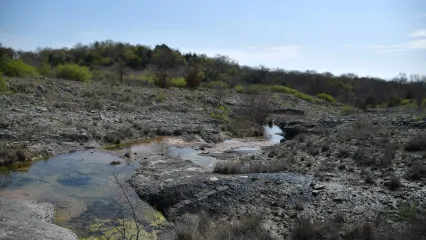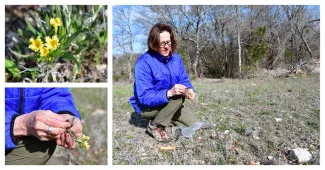If it photosynthesizes and grows in Oklahoma, chances are it’s on Amy Buthod’s radar. As the Oklahoma Biological Survey’s Botanist and the Robert Bebb Herbarium’s Collections Manager, Buthod is charged with inventorying the state’s plant communities and tracking the status of Oklahoma’s rarest species.

Arbuckle Springs WMA is located in the Arbuckle Uplift near Bromide and consists of plains and rolling hills on limestone. The extensive limestone outcrops support a regionally unique plant community.
Buthod’s work has taken her across Oklahoma’s incredibly diverse ecoregions – from the high plains to the cypress forests – but her latest project has landed her where prairie and forest meet at the Wildlife Department’s 3,874-acre Arbuckle Springs Wildlife Management Area.
“This area has a really interesting plant community,” Buthod said. “These limestone outcroppings have a suite of plants that just aren’t found outside of the Arbuckle Plains. The light-colored rocks can attract a lot of the sun’s rays and it can get really bright and really hot.”
To adapt to these harsh growing conditions, a lot of the plants in the region have grayish hairs that are thought to diffuse the intense light and heat, allowing the plants to survive where other species can’t.
Buthod will make monthly visits to the WMA throughout the 2023 growing season to document every plant sprouting on the area. At least one specimen of every plant species will be collected from the area for inclusion in the Bebb Herbarium, and the complete species list will also be shared with the Wildlife Department.

Buthod’s first plant collection on Arbuckle Springs WMA was the relatively common fringed puccoon (Lithospermum incisum). The name “puccoon” comes from the red dye that can be extracted from the plant’s roots. Buthod has special permission from the Wildlife Department to collect plants on the WMA.
“When you conduct research, you must follow the scientific method; you have to carefully explain your methods and the results must be repeatable. For botanists, plant collection is our main way of documenting our methods and showing our results.”
The responsibly collected plants will not only serve as proof that the species can be found at Arbuckle Springs WMA, but also serve as a learning resource. Once the plants have been pressed, dried, frozen, formally identified, and labeled, they’ll be accepted into the herbarium where other botanists and plant enthusiasts can visit the collection, view the specimens, and learn how to identify the plants. Researchers also have special access to the specimens to extract DNA for genetic studies.

Buthod will explore Arbuckle Springs WMA throughout the 2023 growing season, documenting the species diversity, and making special note of plants that have limited records or are considered rare.
This isn’t Buthod’s first plant inventory in the larger Cross Timbers ecoregion. A similar inventory, conducted from 2014 to 2017 at The Nature Conservancy’s nearby Oka’ Yanahli Preserve, documented 602 plant species. While there is likely a lot of overlap in the two area’s plant inventories, this six-year replication can expand the scientific understanding of the region’s overall plant community and may yield biologically important differences.
As Buthod traverses Arbuckle Springs WMA for her 2023 inventory, she will be keeping a trained eye peeled for plant species that have limited collection records. Before making her first field trip to the area in late March, she searched several databases to identify which plant ranges extended into the Arbuckle Plains region, and which plants may have incomplete records. One such plant, a low-growing shrub known as Missouri maidenbush, Phyllanthopsis phyllanthoides, has only been collected in Oklahoma six times in the past 30 years and has never been collected in Johnston County. Yet a search of iNaturalist, a web-platform that allows nature enthusiasts to share details of their observations, indicated a large population of the plant may be growing on the Wildlife Management Area. This iNaturalist report will allow Buthod to do targeted searches in the vicinity to confirm its presence and formally document the county’s new record.
With Buthod’s plant inventory and rare plant monitoring work at Arbuckle Springs WMA, the Wildlife Department will have a better understanding of the area’s underlying plant community and will be better able to focus invasive plant management efforts and plan other management activities that will benefit Oklahoma’s wildlife populations.